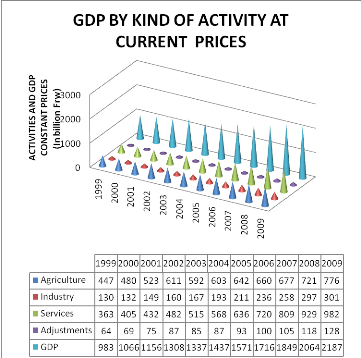4.1.3. System of National
Accounts of Rwanda
Due to technical reasons that include huge informal and
non-monetary sectors (about 65% of the economy in 2006) and data availability
among others, in Rwanda National Accounts are only compiled using the Out
Put/Production approach. On the other hand as far as the expenditure
approach is concerned, it is only the final household expenditure that cannot
be measured on a yearly basis. Hence in this case it can then be calculated by
subtracting as a balancing item from the output approach (Republic of Rwanda,
NISR, 2010, GDP Annual Estimates for 2009 based on 2006 benchmark).
.
Therefore finally GDP estimates of both the production and
expenditure approaches are computed annually in Rwanda. National Accounts are
estimated by economic activities which are classified according the
International Standard Industrial Classification of all economic activities
(ISIC). This is used alongside the United Nations Central Product
Classification (CPC) that is linked to the Harmonized System (HS) used for
classifying international trade (Republic of Rwanda, NISR, 2010, GDP Annual
Estimates for 2009 based on 2006 benchmark).
All these, are adapted to Rwanda's development level keeping
their framework as much as possible. The Industries include:
A.Agriculturea.- Food cropb.- Export cropc.- Livestockd.- Forestrye.-
FisheriesB.- Industrya.- Mining and quarryingb.- Manufacturingc.- Electricity,
gas and waterd.- ConstructionC.- Servicesa.- Whole sale and retail tradeb.-
Hotels and restaurants. Transport, storage and communicationd.- Finance,
insurancee.- Real estate, business servicesf.- Public
administrationg. Educationh.- Healthi.- Other
personal services (trade unions, religious activities, sporting, hair dressing,
domestic services, visiting national parks etc) (Republic of Rwanda, NISR,
2010, GDP Annual Estimates for 2009 based on 2006 benchmark).
.
In Rwanda, national accounts are estimated on an annual basis
by the National Institute of Statistics of Rwanda and from time to time the
estimation methodology is revised due to reasons that include: improvement in
data sources and systems and changes in the national economic structure.
In this regard the first benchmark of 2001 was done in 2003 and now the
National Institute of Statistics of Rwanda is in the process of rebasing the
benchmark to 2006. The rebasing exercise is practically possible two
years after the intended base year which in this case is 2006. This allows for
the use of final approved data for 2006 base year and 2007 current year.
4.1.4. Rwanda's Economic
Emergency
In 2009 Rwanda's gross domestic product (GDP) grew by 4.5% and
is projected to recover moderately in 2010 to 5.1%. The impressive growth that
the country has experienced over the last six years has largely been driven by
the good performance of the agricultural sector. However, the government is
making efforts to diversify the economy as a long-term strategy for sustaining
long-term growth.

In particular, Rwanda is the second most densely populated
country in sub-Saharan Africa after Mauritius with a population density of 384
inhabitants per square kilometer in 2008. While practical steps have been
taken to address environmental challenges stemming from population pressures,
which threatened agricultural productivity, further productivity growth in
agriculture is likely to require higher investment levels than has been the
case before. In addition, 28% of Rwandans are food-insecure in spite of
improvements in this field. The country also remains highly dependent on
foreign aid, which accounted for more than 45% of the government budget in
2009.
In view of the country's land-locked location and its limited
natural resources, the services sector is considered a strategic one, with a
potential to spur long-term growth and transform the economy. This process
should be driven by technology and knowledge-based activities, yet currently
the country has a shortage of skilled labor.
Rwanda is taking steps to address the developmental
challenges. In this context, its medium-term development strategy, the Economic
Development and Poverty Reduction Strategy (EDPRS) and the long-term strategy
Vision 2020 Umurenge provide the policy framework and government priorities for
economic and social development. Vision 2020 prioritizes expansion of non-farm
activities that increase efficiency in service delivery and better targeting of
social safety nets.
Building on its previous policies, Rwanda has scored major
successes. The country has been identified as the top reforming economy in
Africa. The business environment and governance indicators have also improved
and Rwanda has a lean and efficient public administration structure. Policy
reforms are expected to continue following the success of the coalition under
the ruling Rwandan Patriotic Front (FPR) in the parliamentary elections in
2008.
Furthermore, the current government has pursued macroeconomic
stability as one of its major objectives. The spike in year-on-year inflation
above 22% at the end of 2008, caused by fuel and food price increases, had
fallen to below 6% by the end of 2009. This sharp drop in inflation in 2009 was
a result of many factors, including, among others, falling international fuel
and food prices, the domestic credit crunch and prudent monetary policy.
The policy reforms, however, have not yet brought about the
structural changes that are necessary to achieve significant poverty reduction
and lower levels of unemployment, with agriculture still dominating the overall
growth outcomes. In addition, the slow pace in job creation in the formal
sector has resulted in a large informal sector estimated to have contributed
48% to GDP in 2008. This large informal sector has posed serious challenges to
tax revenue mobilization in spite of the increase in tax collection and tax
efficiency over the past three years. As a result, Rwanda still faces a
challenge in widening its tax base.
Continuing efforts to improve the business environment and
intensification of tax education should help increase tax compliance and a
widening of the tax base. More importantly, economic diversification supported
by a vibrant private sector, attracting formal business investors in
labor-intensive activities, should be part of the strategy aimed at reducing
poverty and unemployment.
| 


